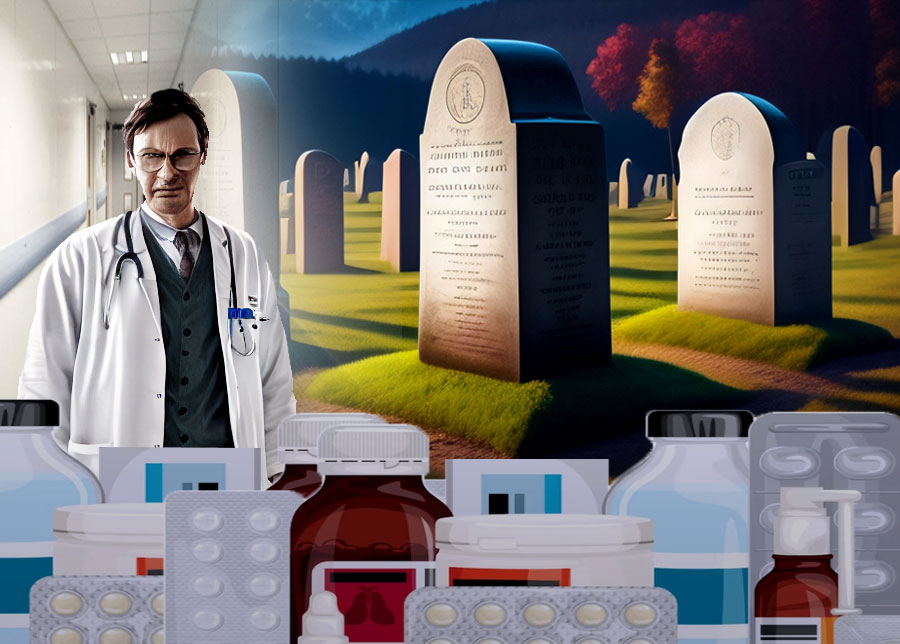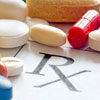A Prescription for Illness: Dying to be Healthy ~ Part II
 by Dawn Lester & David Parker
by Dawn Lester & David Parker
It is widely acknowledged that ‘risks’ are associated with the use of medicines, as explained by Dr Dean in Death by Modern Medicine in her reference to a report produced by the U.S. GAO (General Accounting Office), which found that, “…of the 198 drugs approved by the FDA between 1976 and 1985…102 (or 51.1%) had serious post-approval risks…”
The ‘risks’ listed in the report include heart failure, kidney and liver failure, and birth defects, which provide clear evidence of the dangers that can result from ‘approved’ drugs. The fact that these serious conditions had not been identified prior to the approval of the drugs indicates serious problems with the drug testing procedures, as well as with the original consideration that the compounds were appropriate for use as a medicine. Professor Sheldon Krimsky PhD offers a suggestion, in his book entitled Science in the Private Interest, of the reason why questions are not raised over drug testing procedures; he states that, “Among the tens of thousands of clinical trials occurring each year, most are funded by for-profit companies seeking to gain FDA approval for new drugs, clinical procedures or medical devices.”
This situation is not improving; it is, in fact, a worsening problem, that refer to the increasing level of control over the medical system that has been gained by profit-seeking pharmaceutical companies and other vested interests.
A large proportion of pharmaceuticals are manufactured by American drug companies, which means they require approval by the U.S. FDA (Food and Drug Administration). It is likely that the vast majority of people assume that this approval process means that all drugs on the market have been scientifically proven to be both safe and effective, because it is only after approval that drugs can become available for prescription to patients. It should be expected, therefore, that the FDA conducts its own rigorous tests prior to approving any drug as a suitable ‘medicine’ for public consumption.
Unfortunately, this is not the case, as Dr David Michaels PhD explains in his book entitled Doubt is Their Product, “Under the U.S. system, the pertinent regulatory agency – the Food and Drug Administration (FDA) – grants licenses for new medications based on its review of the various laboratory tests and clinical trials reported by the companies themselves. The FDA can study the data and the results as reported, but it has neither the staff nor the resources to duplicate the work itself.”
There are many problems with the drug industry’s approach to the development of a ‘medicine’. The first is that the initial ‘effect’ is merely an isolated chemical reaction within a laboratory environment. Secondly, many laboratory animals that are used for testing exhibit certain functional differences from humans. Thirdly, all ‘drugs’ have effects in addition to those that are intended; these are called ‘side effects’ and include a variety of symptoms that demonstrate the harm that they can cause.
Pharmaceutical ‘medicines’ are, however, harmful; the reason for this is due to the nature of the chemicals used in their manufacture, many of which are inherently toxic and all of them are physiologically incompatible with the human body.
One extremely useful document that explains the manufacturing processes and the ingredients used by the pharmaceutical industry is called Pharmaceutical Waste Analysis. This document was produced in 2006 by the Blacksmith Institute and is also available from their website Pure Earth (pureearth.org).
One of the pharmaceutical manufacturing processes, called ‘fermentation’, is employed in the production of antibiotics and steroids; two of the most widely used drugs. The process of fermentation involves the use of solvents, some of which are discussed in the Pharmaceutical Waste document that states, “…the solvents most often used in fermentation operations are acetone, methanol, isopropanol, ethanol, amyl alcohol and MIBK.”
All of these solvents are toxic. MIBK stands for methyl isobutyl ketone, which is claimed to be of ‘low toxicity’, although the document states that it may damage the liver, which clearly refutes the claim of ‘low’ toxicity.
Another pharmaceutical manufacturing process is called ‘chemical synthesis’, which is the production method used for most of the active ingredients in a wide variety of drugs; this process also involves a number of highly toxic substances as the Pharmaceutical Waste document explains, “A variety of priority pollutants are used as reaction and purification solvents during chemical synthesis.”
The document provides a list of some of the ‘priority pollutants’ that are used in the process of chemical synthesis; they include, “…benzene, chlorobenzene, chloroform, chloromethane, o-dichlorobenzene, 1,2-dichloroethane, methylene chloride, phenol, toluene and cyanide.”
The term ‘priority pollutants’ means that these substances are known to be extremely hazardous chemical compounds.
The processes described above are not the only ones used in the production of ‘medicines’; but they serve as examples to demonstrate that the manufacture of drugs involves the use of highly toxic substances. The concern expressed by the document refers to the hazardous nature of the waste produced by the industry and the effects of these wastes on the environment.
The information contained within the document clearly identifies the toxic nature of the substances used in the manufacturing processes, as well as the ingredients utilized by the pharmaceutical industry in the production of ‘medicine’, and provides supportive evidence for the claim that medicines are inherently harmful. This fact has also been identified by Herbert Shelton who states that, “All so-called medicines, in doses of any size, are poisons.”
It is therefore unsurprising that all drugs are recognized to produce ‘side effects’; but the degree of harm is invariably understated and mostly hidden, for reasons that will become increasingly obvious. The scale of harm they cause is the subject of the next discussion.
Iatrogenesis
Iatrogenesis, which is derived from the Greek word for doctor, is a recognized phenomenon, the establishment definition of which refers to a condition that, “…has resulted from treatment, as either an unforeseen or inevitable side-effect.”
The ‘medicines’ of the early 21st century are perceived to be a ‘modern miracle’ for their ability to combat the many hundreds of different diseases to which humans are able to succumb. A substantial part of this ‘miracle’ is regarded as having been achieved through advances in ‘medical science’ coupled with the use of highly sophisticated technologies. But, as outlined in the previous two discussions, ‘modern medicine’ was not established from a basis in science and the effects of drugs have not been proven to be beneficial for health. The existence of the phenomenon of iatrogenesis demonstrates that medical treatments can, and do, have serious consequences.
Dr Carolyn Dean is one of the many physicians who have recognized the failings of the orthodox medical system in which they were trained. In Death by Modern Medicine, she refers to the history of the use of chemicals in ‘medicine’ and states that, “From the beginning, chemical drugs promised much more than they delivered. But far beyond not working, the drugs also caused incalculable side effects.”
The establishment definition of a ‘side-effect’ refers to, “an unwanted effect produced by a drug in addition to its desired therapeutic effects. Side-effects are often undesirable and may be harmful.”
The description of an iatrogenic condition as a ‘side effect’ is clearly misleading, because it is a condition that is recognized to have resulted from a ‘treatment’; in other words, it is a direct effect of treatment. An iatrogenic condition is obviously not the intended effect of any treatment, but to relegate it to the label of ‘side effect’ is disingenuous; especially since all drugs are recognized to produce effects, many of which are far more harmful than the original disease.
No ‘side effect’ is desirable, but the fact that they occur and are described as ‘unforeseen’, ‘unwanted’ and ‘undesirable’ is a clear demonstration of a woefully inadequate level of knowledge within pharmacology, and especially within pharmacodynamics.
The reason that patients are prescribed the same pharmaceutical drugs for the same condition is based on a mistaken idea about the processes that result in ‘disease’. This fallacy assumes that all human responses to the same disease will be uniform, because it is claimed that a ‘disease’ is an independent entity that ‘attacks’ all people alike, and therefore the appropriate treatment is one that will fight the disease entity. This fallacy is also the basis for the use of tissues or ‘disease molecules’ in laboratory experiments.
Although it is likely that there will be certain similarities in the effects that people experience from the same drug, humans are not ‘machines’; no two human bodies are exactly the same and therefore their experiences will not exactly correlate. The medical establishment claims that the reason some people experience adverse effects, whereas others do not, is because they have a ‘problem’. The most common explanation for this problem is that these people have ‘faulty genes’; but this is yet another mistaken idea. The information produced by the Human Genome Project has undermined many fundamental assumptions about the importance and role of genes in the human body.
The medical establishment does acknowledge that people react differently to drugs, as Richard Smith explains in his previously cited October 1991 editorial, “The weakness of the scientific evidence underlying medical practice is one of the causes of the wide variations that are well recognized in medical practice.”
It is not only the evidence that is weak, the theories underlying medical practice are also weak because they fail to recognize the real nature of the human body, which is a self-regulating organism that is far from inert, machine-like and predictable.
The symptoms called ‘side effects’ that are produced by a ‘medicine’ are likely to be viewed as a new condition, or illness, for which the patient will often be prescribed another ‘medicine’, but this too will inevitably produce another set of ‘side effects’. This recurring problem is summarized by Herbert Shelton, who states, “There are no drugs that do not produce side effects and it is certain that the more toxic of them invariably produce iatrogenic disease.”
It is therefore more appropriate to state that all ‘effects’ of all drugs should be referred to as iatrogenesis.
One of the first analyses of the scale of the problem of ‘iatrogenesis’ in the U.S. was conducted by Dr Barbara Starfield MD and reported in her July 2000 article entitled Is US Health Really the Best in the World? that was published in the Journal of the American Medical Association. In her article, Dr Starfield wrote about the dreadful state of healthcare and included details of the ranking of the U.S. by comparison to other countries in respect of certain criteria. For example, the U.S. ranked 12th out of 13 ‘Western’ countries with respect to life expectancy; an appalling situation considering the huge sums of money spent on healthcare in the U.S.
The quality of healthcare for Americans has continued to worsen since 2000, as indicated by a November 2013 article entitled We’re No 26! U.S. is below average on most health measures; the title is self-explanatory.
In her article, Dr Starfield exposed a range of problems including the high cost of healthcare and the low ranking of the U.S. in health criteria. She also revealed important statistics about adverse effects that have been the direct result of ‘healthcare’ interventions; these statistics include 12,000 deaths per year from unnecessary surgery and 7,000 deaths per year from medication errors in hospitals. Her comment on this situation is that, “The high cost of the health care system is considered to be a deficit, but seems to be tolerated under the assumption that better health results from more expensive care, despite evidence from a few studies indicating that as many as 20% to 30% of patients receive contraindicated care.”
One of the statistics provided in the article is of particular relevance to this discussion, as Dr Starfield reports that an annual total of 106,000 deaths occurred as the result of ‘non-error adverse effects of medications’; which refers to medications that had been correctly and appropriately prescribed and administered. This particular statistic provides unequivocal evidence not only of the existence of iatrogenesis, but also of the potentially vast scale of the problem.
The first comprehensive study to be conducted on the subject of iatrogenesis in the U.S. was published in 2003. This study, entitled Death by Medicine, collated statistics from thousands of published studies on all causes of illness; it was co-authored by Dr Gary Null PhD, Dr Carolyn Dean MD ND, Dr Martin Feldman MD, Dr Debora Rasio MD and Dr Dorothy Smith PhD. The abstract of the study begins, “A definitive review and close reading of medical peer-review journals and government health statistics shows that American medicine frequently causes more harm than good.”
The total number of deaths from iatrogenesis was stated in this study to be an estimated 783,936 per year; a figure that exceeds the annual mortality from either heart disease or cancer, which makes iatrogenesis the leading cause of death in the U.S. Death is clearly the most extreme iatrogenic effect; but there are many other adverse health events that can follow the administration of pharmaceutical drugs, as the study states, “Each year approximately 2.2 million U.S. hospital patients experience adverse drugs reactions to prescribed medications.”
It must be emphasized that these figures only refer to the situation in the U.S. and only relate to hospital patients.
The existence of huge numbers of adverse events resulting from the use of drugs is an absolutely unacceptable component of a ‘healthcare’ system. But even these numbers do not represent the full extent of the problem, as it is not restricted to the U.S.; it is a worldwide phenomenon that exists wherever pharmaceutical drugs are used.
The fact that the worldwide effect of this phenomenon has not been studied and documented does not mean that it is not a genuine situation and a real problem. Furthermore, it is acknowledged that these statistics are not representative of the true situation, because adverse effects are known to be grossly under-reported, as the study also states, “As few as 5% and no more than 20% of iatrogenic acts are ever reported.”
In the 2008 edition of her Death by Modern Medicine book, Dr Carolyn Dean, also one of the 2003 study authors, reports that the numbers of iatrogenic deaths and injuries have continued to increase. The current scale of the problem is unknown, but in view of the ever-increasing consumption of pharmaceutical drugs around the world, it is inevitable that it will have continued to escalate.
Although the pharmaceutical industry is clearly reluctant to admit that their products are toxic, there is undeniable evidence of the harm they cause, as documented by the many drugs that have been withdrawn from the market due to their adverse effects, as Dr Dean explains, “Fully half the drugs prescribed are eventually pulled from the marketplace due to undeniable side effects.”
Her statement is based on the U.S. GAO report referred to in the previous section. However, because pharmaceutical drugs are not officially recognized as being inherently toxic, the true scale of the problem is not only unknown, but unknowable. An added complication that further masks the magnitude of the problem is that the ‘effects’ of drugs are not always immediately obvious and can take months or even years to develop, which means it is highly unlikely that an illness will be associated with the prior use of any medication.
It is abundantly obvious that iatrogenesis has far more victims than has been acknowledged or reported, but this situation is predominantly due to the suppression of facts about the toxicity of pharmaceutical products, which is the direct result of the toxic chemicals used in the manufacturing processes.
‘Medicines’ are supposed to heal not harm; yet, as Dr Dean states, “How modern medicine has come to be the number one killer in North America is as incredible as it is horrifying. Doctors certainly don’t think of themselves as killers but as long as they promote toxic drugs and don’t learn nontoxic options, they are pulling the trigger on helpless patients.”
This is a dire situation; but it is not unique to North America; it will exist within all countries that adopt the WHO-led medical establishment system.
It is clear that expensive ‘healthcare’ does not result in better health for people; it does however, provide healthy profits for the pharmaceutical and medical technology industries. The existence of iatrogenesis demonstrates that a health system based on the use of toxic pharmaceutical ‘medicines’ is unable to deliver healthcare, no matter how much money is spent, how sophisticated the technology or how new and innovative the drugs that are used.
Health is not something that will improve by merely increasing healthcare budgets or by spending larger amounts of money on the development of new ‘medicines’, as the American system has proved. Health can only be improved by identifying and addressing the real causes of illness.
Psychiatric Medications
The establishment definition of psychopharmacology refers to, “the study of the effects of drugs on mental processes and behavior, particularly psychotropic drugs.”
The chemical compounds that are used in ‘medicines’ affect many parts of the body including the brain; this means that the brain can be affected by ‘medicines’ prescribed for conditions other than those referred to as ‘mental health’ problems.
The reason that a branch of ‘science’ studies the effects of pharmaceutical drugs on ‘mental processes and behaviors’ is because certain ‘behaviors’ are considered to be ‘abnormal’ and therefore people who exhibit such behaviors are deemed to have a ‘mental illness’, also referred to as a ‘mental disorder’; as indicated by the April 2018 WHO fact sheet entitled Mental Disorders that states, “There are many different mental disorders, with different presentations. They are generally characterized by a combination of abnormal thoughts, perceptions, emotions, behavior and relationships with others.”
The problem with this statement is that it relies on a highly subjective analysis of what is perceived to be ‘abnormal’ with reference to all the criteria by which a diagnosis is made. Yet nowhere is there a definitive definition of ‘normal’; it is neither a medical nor a scientific term. Nevertheless, when a person’s thoughts or behaviors are considered to be ‘abnormal’ and they are diagnosed with a ‘mental disorder’ they are frequently prescribed ‘medications’ which, like all ‘drugs’, are made using toxic chemicals. The fact sheet suggests that insufficient numbers receive such treatments and states, “Health systems have not yet adequately responded to the burden of mental disorders. As a consequence, the gap between the need for treatment and its provision is wide all over the world.”
The definition of ‘health’ as declared in the WHO constitution, includes reference to mental as well as physical well-being, which further demonstrates the disparity between the ideas they promote and the practices they recommend. It is another example of the contradictions that pervade the medical establishment system.
The use of drugs for the treatment of people diagnosed with a mental disorder is based on the theory that people with such conditions have developed a ‘biochemical imbalance’ within their brain. Despite its frequent use, the phrase ‘chemical imbalance in the brain’ is based on yet another unproven theory, as psychiatrist Dr Peter Breggin MD has explained many times during the course of his long and distinguished career. His website contains a great deal of useful material and articles, including his June 2015 article entitled Rational Principles of Psychopharmacology for Therapists, Healthcare Providers and Clients, in which he refers to the theory of ‘biochemical imbalance’ as being both false and a myth. In his article, he states that, “…the evidence for any biological basis for ‘psychiatric disorders’ is utterly lacking.”
In his 1991 book entitled Toxic Psychiatry, Dr Breggin explains the situation in more detail and states that, “…no causal relationship has ever been established between a specific biochemical state of the brain and any specific behavior and it is simplistic to assume it is possible.”
He further explains that, “There’s little evidence for the existence of any such imbalances and absolutely no way to demonstrate how the drugs would affect them if they did exist.”
One fact that is rarely highlighted by the medical establishment is that patients undergo no tests that are able to determine whether they have a biochemical imbalance in their brains. Dr Breggin states that the only tests capable of determining the existence of any biochemical imbalance would only be carried out during an autopsy!
In his June 2015 article Dr Breggin explains why drugs appear to have an effect, “All drugs that impact on the brain and mind ‘work’ by partially disabling the brain and mind.” He further explains that, “The so-called therapeutic effect is always a disability.”
He describes these disabilities as always representing a diminished quality of life. Dr Breggin’s comments clearly add further credence to the discussion in the previous section, in which it was shown that all drugs produce adverse effects; the interpretation of these effects as ‘therapeutic’ is not only highly subjective, it has no basis in ‘science’.
One of the most common types of ‘mental disorder’ is depression, the establishment definition of which is, “a mental state characterized by excessive sadness.”
The problem with this definition, as should be immediately obvious, is that it too is based on a subjective interpretation of the level of sadness that would constitute ‘excessive’. It is highly likely that different physicians will have differing interpretations of the meaning of ‘excessive’, which means that the ‘treatments’ offered to patients can vary amongst physicians according to their particular and personal interpretations. Not only does this highlight the absence of a standardized healthcare system, but also refutes any idea that physicians are in possession of a clear definition of ‘normal’ by which they can determine what is ‘abnormal’.
The WHO regards depression as a distinctive condition that differs from ordinary emotional responses to the everyday challenges of life; the definition in the March 2018 WHO fact sheet entitled Depression claims that, “Depression is a common mental disorder.”
The WHO estimates that depression affects more than 300 million people around the world, which clearly represents a huge potential market for the products of the pharmaceutical industry. Yet the distinction made by the WHO between emotional responses and depression relies purely on duration and severity. Both of these criteria are similarly subjective and unhelpful in providing a method for determining any clear distinctions between an ordinary emotional response to the difficulties of life and depression; if any genuine distinctions do exist. Dr Breggin suggests that there are no such distinctions and that emotions are normal aspects of being human. He expands on this point in Toxic Psychiatry and states that, “Depression and elation are among the most common human experiences.”
In this context, depression should not be considered as ‘abnormal’ and as an illness or disorder that requires a patient to be medicated so that they can return to ‘normal’. Depression frequently follows a tragic and distressing event in a person’s life, such as the death of a loved one, for example. It should be recognized that people are different in many ways and that these differences include the way they respond to the emotional challenges of life. The theory that a certain level of emotional response is ‘abnormal’ has no basis in science; it is a social construct.
Dr Breggin explains the origin of the idea that a certain level of emotion is to be considered as a ‘mental health problem’ that requires treatment and states that, “Psychiatry and the pharmaceutical industry have been marketing depression as a ‘real disease’ in need of medical treatment.”
Despite the absence of a genuine biochemical theory of depression and associated ‘behaviors’, as well as the lack of any test to determine the existence of a ‘chemical imbalance’, millions of people around the world have been regularly prescribed drugs to treat their alleged ‘mental disorder’. This is a highly lucrative market for the pharmaceutical industry, especially in view of the WHO claim that there is an ‘under-provision’ of treatment. In addition, the WHO fact sheet claims that, “There are effective psychological and pharmacological treatments for depression.”
Pharmacological treatments include antidepressants, the establishment definition of which is, “a drug that alleviates the symptoms of depression.”
There is however, a large and growing body of evidence which demonstrates that antidepressants do not genuinely alleviate the symptoms of depression. Although patients may perceive that their symptoms have abated due to the drugs, Dr Breggin explains that this is often a mistaken perception, and that changes in the symptoms people experience tend to mask the existence of the disabling effects of the drugs.
It is widely acknowledged that all drugs produce ‘effects’, some of which are extremely harmful; the same applies to antidepressants. Some of the dangerous effects of antidepressants are revealed by Dr Peter Breggin and David Cohen PhD in their book entitled Your Drug May Be Your Problem, in which they state that, “At public hearings in 2004 the FDA presented re-evaluations of antidepressant clinical trials for children and youth under age eighteen documenting that the suicide risk was doubled in children taking antidepressants compared to similar individuals taking a sugar pill.”
The result of these hearings was a limited action, which was that, “The FDA published a new required label for all antidepressants on January 26, 2005 including a black box headlined ‘Suicidality in Children and Adolescents’.”
Whilst ‘increased suicidality’ is a more than adequate reason to be extremely concerned about these drugs, they are associated with many other ‘side effects’. The acknowledged ‘side effects’ of antidepressants include the following symptoms: anxiety, agitation, panic attacks, insomnia, irritability, hostility, aggressiveness, impulsivity, akathisia (psychomotor restlessness), hypomania, and mania. These symptoms are often similar to, and in some cases the same as, the symptoms for which the drug would have been originally prescribed.
Dr Russell Blaylock MD, a former neurosurgeon, discusses the use of antidepressants in his book entitled Health and Nutrition Secrets, in which he refers to many of the ‘side effects’ of ‘psychiatric medications’ and particularly the effects that they have produced in young people, “It is also interesting to note that in virtually all of the school shootings, the kids responsible for the violence were taking SSRI medications, which are known to produce suicidal and homicidal side effects. It is also known that these medications increase brain levels of the neurotransmitter serotonin, which in high concentrations can also act as an excitotoxin.”
There has, however, been a recent change in the approach of the medical establishment towards the use of SSRI (selective serotonin re-uptake inhibitor) medications for children and teenagers. The WHO fact sheet about depression refers to antidepressants and states that, “They should not be used for treating depression in children and are not the first line of treatment in adolescents, among whom they should be used with extra caution.”
This is clearly a better approach but it should have been implemented many decades ago, as it would have saved countless children and young people from being damaged by these drugs; although the best approach would be one that avoids drugs entirely.
One drug that is still prescribed for young children is Ritalin, which is one of the trade names of a compound called methylphenidate that is referred to as a central nervous system stimulant. Ritalin is described as ‘amphetamine-like’, which is the reason it was previously referred to as one of the legal drugs that are similar to ‘illegal’ ones. Ritalin is used for ‘behavioral disorders’ such as ‘ADD’ and ‘ADHD’, which are conditions claimed to be suffered by some young children who are considered to have problems paying attention, particularly in school. Some of the ‘side effects’ of this drug include: loss of appetite, mood swings and stomach aches. Dr Breggin comments on the effects of Ritalin in Toxic Psychiatry and states, “It seems to have escaped Ritalin advocates that long-term use tends to create the very same problems that Ritalin is supposed to combat – ‘attentional disturbances’ and ‘memory problems’ as well as ‘irritability’ and hyperactivity.”
The reduction or alleviation of symptoms is perceived to be a successful outcome of treatment, which means that any reduction in the feeling of depression will be similarly perceived to be a successful outcome; but, as with all drug treatments, they do not address the real causes of the strong emotions that many people experience.
Dr Breggin summarizes his own approach to depression in Toxic Psychiatry, in which he states that, “Despite all of this bio-psychiatric propaganda …depression is a readily understandable expression of human despair that is frequently responsive to psycho-social help.”
NOTE: It must be emphasized that anyone who takes psychiatric medications must seek competent professional advice if they wish to consider or to undertake a withdrawal programme, as there are many potential effects that withdrawal from these drugs can produce. In his 2015 article, Dr Breggin states that, “Withdrawing from psychiatric drugs can be emotionally and sometimes physically dangerous. It should be done carefully with experienced supervision.”
Excerpt from What Really Makes You Ill – Why Everything You Thought You Knew About Disease Is Wrong
See Part I here.
See Part III here.
Posted in Health, Other Topicswith comments disabled.





